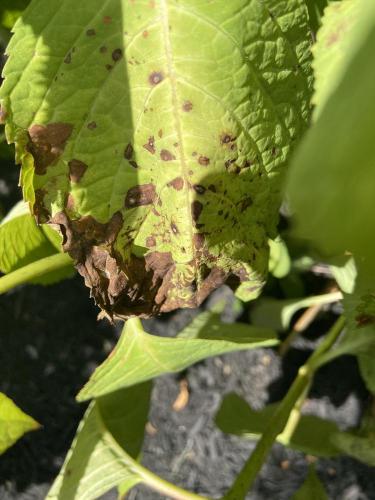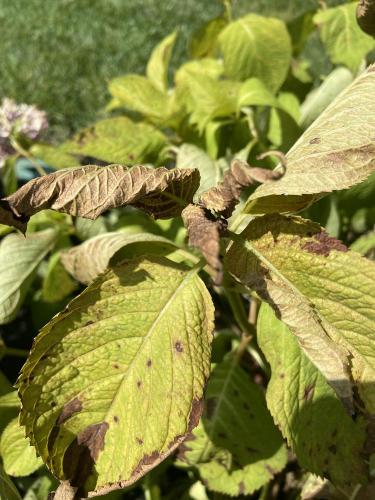* The leaf spots are fungal or bacterial infections triggered by either overwatering, a humid environment or overhead watering:
An average of watering every other day for 8-10 minutes is hard to convert to gallons of water but it does not sound like it is a lot. However, you can run a quick test to see if it is sufficient by: watering once the soil feels dry at a depth of 6-8 inches; waiting for the water to percolate; and then inserting a finger into several spots under the drip line at a depth of 8" or more to see if the soil feels dry, damp/moist or wet/soggy. If it feels dry, you may have missed a spot, the soil is draining too slowly for some reason (wait longer to do this test?) or you did not use enough water. Watering a hydrangea based on a schedule (like every "x" days") can be tricky in the summer or during unstable weather conditions. To know when to water, inset a finger into the soil and water of the top few inches of the soil feel dry or almost dry. On a typical, newly planted hydrangea, a depth of 4" is enough as hydrangea roots are shallow, tiny and fibrous. On an established hydrangea like yours, the roots will go deeper than 4" but it is hard to guess how much via pictures. Note: a common symptom of needing water is when the leaves brown out from the edges inwards.
Humidity can be a problem for you. Medford is usually comfortable but summer months can be sticky or muggy. July is typically the worst and June-August are the most humid months, with lower humidity for the rest of the year. This condition promotes and helps spread the pathogens that can cause leaf spots.
Overhead watering can also be problematic and help develop and spread fungi so the usual recommendation is to never water the hydrangea leaves, only water the soil. Typical suggestions are to use soaker hoses or drip irrigation. However, in the case of a single specimen in the landscape -like in the picture- this is not practical as you have lawn to also water. In this case, I would make sure that the station that waters the hydrangea activates around 6-8am or so, such that the leaves do not remain wet for long periods of time.
So confirm that the plant is getting sufficient soil moisture as mentioned before. Minimize -as best as you can- the time that leaves may be wet during the watering process. You can also use fungicides to control -not cure- leaf spots.
Fungicides registered for the control -not the cure- of Cercospora leaf spot (listed by active ingredient): copper octanoate (Bonide Liquid Copper Fungicide); azoxystrobin (Heritage; has the smallest application rate and the largest repeat interval); chlorothalonil (Bonide Fung-onil Fungicide, Daconil); mancozeb (Dithane; Protect; other names); myclobutanil (Immunox); thiophanate-methyl (Cleary's 3336). Some of these can be harsh chemicals so wear gloves. I have seen some of the Bonides for sale at Lowes. Since my affected hydrangea has attained good control of this leaf spot and is not spreading it to others just a foot away after 10+ years, I no longer use fungicides (I used copper fungicides and now I use drip irrigation and clean sanitation practices) but I collected –and have not tested- the efficacy of some advertised organic fungicide cercospora solutions that were recommended for infected plants entirely different from hydrangeas. These included: fungi Trichoderma at 5-10 grams per liter; on a cloudy, cool day, spray a solution of 1 tbsp of apple cider vinegar diluted in a gallon of water on both leaf sides and soil every 3 days; on a sunny but not hot day, spray a solution of 1 part milk + 8 parts water on both leaf sides, stems and soil weekly; spray early in the day (or at night when cool), a solution of 1.5 tbsp of Neem Bliss Oil by Plantonix with Azadirachtin + quart of water + 1 tsp of liquid dish soap to leaves and stems; 12 tbsp of hydrogen peroxide diluted in a gallon of water on both leaf sides, stems and soil weekly. Since I have not tested these myself and they were not mentioned with hydrangeas in mind, I recommend testing any that interest you with a few leaves for two days first to see if there are any adverse effects in the sampling area of the shrub (things like leaf discoloration, etc.). Allow weeks to pass to notice if they control the infections only. Do not expect injured leaves to recover back to their original pristine state.
Plant debris in the fall should be discarded in the trash -not on a compost pile- as it will contain fungi. This includes leaves, blooms, sticks/stems that have fallen down. Hydrangea macrophyllas like this have already started to develop (or have already developed) early spring 2023 flower buds "by yesterday" so avoid pruning now. But deadheading the spent blooms is ok at any time of the year.
This specimen is receiving too much direct sun. Hydrangea macrophyllas typically need dappled sun or morning sun until 11am or so. Afternoon or evening sun makes the leaves in direct contact with the sun turn from dark green to yellow, including the leaf veins. In picture 2, the top foliage was light green or yellowish, while inner foliage seemed to be darker (I admit it is hard to confirm with pictures). Hydrangeas can get some afternoon sun but that should be limited to areas where the summers have temperatures that typically stay below 85°F, which a sampling of a few, short duration temperature spikes above 85°F. This year may just be an anomaly in Medford as summer 2022 temperatures have consistently stayed above 85°F most of the time in July 2022 and even reached 99°F last Sunday.
Lastly, I could not tell if the grass is managing to encroach into the hydrangea's roots area so just keep an eye on that as both, grass and hydrangeas, share shallow roots and you do not want them to comingle and fight for water and nutrients. Also, regular lawn fertilizers tend to be high in nitrogen so be careful not to accidentally spread them into the hydrangeas' roots as that may raise nitrogen levels too much and result in less flowering.
Does that help you?
Luis


